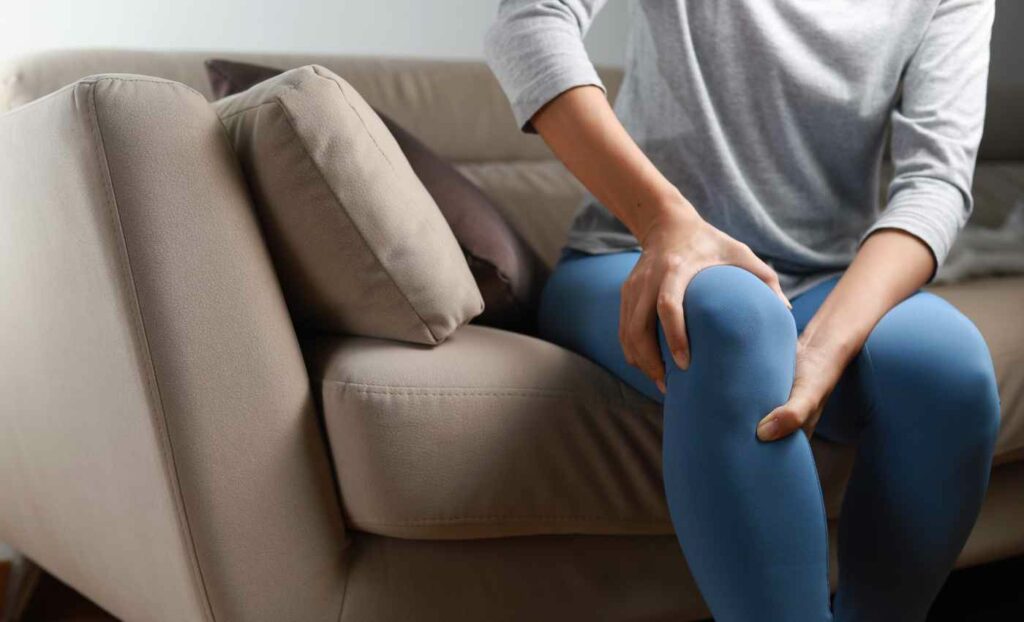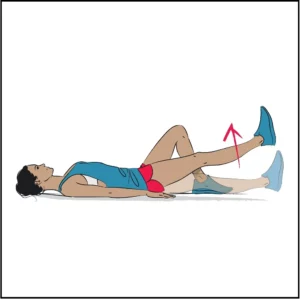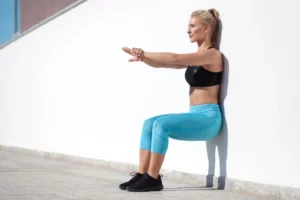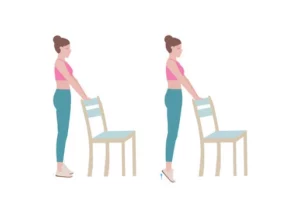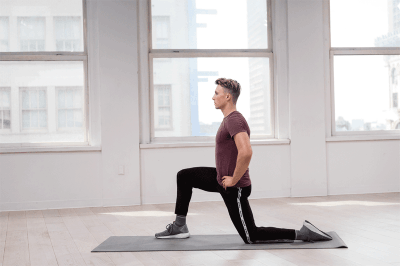Patellar tendonitis, often referred to as “jumper’s knee,” is a common overuse injury that affects the tendon connecting the kneecap (patella) to the shinbone (tibia). This condition can be a real pain, both literally and figuratively, for athletes and active individuals. The good news is that, with the right approach, patellar tendonitis can be effectively managed and even prevented from recurring. One of the key pillars of treatment is patellar tendonitis physical therapy. In this blog, we’ll explore how physical therapy plays a pivotal role in the recovery journey for those dealing with this nagging knee ailment.
Contents
Understanding The Causes Of Patellar Tendonitis%27%20fill-opacity%3D%27.5%27%3E%3Cellipse%20fill%3D%22%23197ba9%22%20fill-opacity%3D%22.5%22%20rx%3D%221%22%20ry%3D%221%22%20transform%3D%22matrix(-34.70702%2045.3949%20-36.88548%20-28.20108%20266%20173)%22%2F%3E%3Cellipse%20fill%3D%22%23556200%22%20fill-opacity%3D%22.5%22%20rx%3D%221%22%20ry%3D%221%22%20transform%3D%22matrix(33.31973%20-44.48613%2035.93784%2026.91713%20279.5%2039.8)%22%2F%3E%3Cellipse%20fill%3D%22%238d7f9a%22%20fill-opacity%3D%22.5%22%20rx%3D%221%22%20ry%3D%221%22%20transform%3D%22matrix(5.64368%2060.89446%20-93.09251%208.62779%20155.3%20154.1)%22%2F%3E%3Cellipse%20fill%3D%22%23949b34%22%20fill-opacity%3D%22.5%22%20rx%3D%221%22%20ry%3D%221%22%20transform%3D%22matrix(-88.59065%20-35.97293%2031.36891%20-77.25232%20147.2%2020.7)%22%2F%3E%3C%2Fg%3E%3C%2Fsvg%3E)
Patellar tendonitis occurs when the patellar tendon becomes inflamed and irritated due to repetitive stress or overuse. It’s a condition often seen in sports that involve frequent jumping, but it can affect anyone who puts strain on their knees regularly.
Key factors that contribute to the development of patellar tendonitis include:
- Overuse and Repetitive Stress: One of the primary causes of patellar tendonitis is overuse and repetitive stress on the patellar tendon. Activities that involve frequent jumping, running, or sudden changes in direction, such as basketball, volleyball, and sprinting, place significant strain on the tendon. Over time, this repetitive stress can lead to tendon irritation.
- Muscle Imbalances: Muscle imbalances around the knee joint can play a significant role in the development of patellar tendonitis. The quadriceps muscles in the front of the thigh, particularly the vastus medialis obliquus (VMO), and the hamstrings at the back of the thigh need to work together to stabilize the knee. When there’s an imbalance between these muscle groups, it can place stress on the patellar tendon.
- Poor Biomechanics: Biomechanical issues, such as improper alignment of the lower extremities or abnormal gait patterns, can increase the risk of patellar tendonitis. These issues can result from factors like flat feet, high arches, or poor footwear choices.
- Inadequate Warm-Up and Stretching: Skipping warm-up routines before physical activity can leave the patellar tendon vulnerable to injury. A proper warm-up and stretching regimen prepares the muscles for the exercise.
- Age and Previous Injuries: Age can also be a factor in the development of patellar tendonitis, as tendon elasticity tends to decrease with age. Additionally, individuals with a history of knee injuries or surgery may be more susceptible as well.
- Genetic Predisposition: Some individuals may have a genetic predisposition that makes them more susceptible to tendon injuries, including patellar tendonitis.
The Role Of Physical Therapy In Patellar Tendonitis Management
Physical therapy plays a vital role in the effective management of patellar tendonitis, helping individuals regain strength, and flexibility while reducing pain. Here’s a closer look at the key aspects of physical therapy in addressing patellar tendonitis:
- Comprehensive Evaluation: Physical therapists begin by conducting a thorough assessment of the individual’s condition, taking into account their medical history, lifestyle, and the severity of the tendonitis. This evaluation guides the development of a personalized treatment plan.
- Pain Management: Managing pain is a primary focus of physical therapy. Therapists may employ techniques like ice and heat therapy, ultrasound, or electrical stimulation to alleviate discomfort and inflammation.
- Stretching and Flexibility Exercises: Physical therapists design specific stretching routines to improve the flexibility of the quadriceps, hamstrings, and calf muscles. Enhanced flexibility reduces strain on the patellar tendon and enhances overall joint mobility.
- Strengthening Exercises: Strengthening exercises target the muscles surrounding the knee, especially the quadriceps. A balanced muscle strength program helps stabilize the knee joint, reducing stress on the patellar tendon.
- Eccentric Exercises: Eccentric exercises involve controlled lengthening of the muscle while it’s under tension. These exercises are particularly effective in rehabilitating the patellar tendon and promoting tissue healing.
- Biomechanical Assessment: Physical therapists assess the individual’s movement patterns and biomechanics to identify any irregularities contributing to tendonitis. Customized exercises and recommendations help correct these issues.
- Activity Modification: Therapists advise on modifying or gradually returning to activities that initially caused or exacerbated the tendonitis. This gradual approach minimizes the risk of re-injury.
- Progress Tracking: Physical therapists monitor progress and adjust the treatment plan accordingly. They may incorporate advanced exercises and techniques as the patient’s condition improves.
- Home Exercise Program: Patients are typically provided with a home exercise program to continue their rehabilitation outside of therapy sessions. Consistent adherence to these exercises is essential for long-term recovery.
Exercises For Patellar Tendonitis Relief
Here, we’ll delve into specific exercises recommended by physical therapists to address patellar tendonitis effectively:
Static Quadriceps Contraction
- Sit with your leg extended, keeping it straight.
- Tighten the quadriceps muscles on the front of your thigh.
- Hold this contraction for 5-10 seconds.
- Repeat for 10-15 repetitions, gradually increasing over time.
Straight Leg Raises
- Lie on your back with one leg extended and the other bent at a 90-degree angle.
- Tighten the quadriceps of the extended leg and raise it to the level of the bent knee.
- Hold briefly and lower the leg.
- Complete 2-3 sets of 10-15 repetitions for each leg.
Wall Sits
- Stand with your back against a wall and feet shoulder-width apart.
- Slowly lower your body by bending your knees until they form a 90-degree angle.
- Hold this position for 20-30 seconds and then stand up.
- Perform 3-4 sets.
Eccentric Decline Squats
- Stand on an inclined board with your heels at the higher end and toes at the lower end.
- Slowly lower your body by bending your knees, focusing on the lowering phase.
- Once at the bottom, use both legs to push back up to the starting position.
- Perform 3 sets of 10-15 repetitions.
Step-Downs
- Stand on a step or sturdy surface with one foot on the step and the other hanging off.
- Slowly lower the hanging foot towards the ground, then return it to the step.
- Perform 2-3 sets of 10-15 repetitions for each leg.
Calf Raises
- Stand with your feet hip-width apart.
- Slowly rise up onto your toes, lifting your heels off the ground.
- Hold briefly at the top and lower your heels back down.
- Perform 3-4 sets of 15-20 repetitions.
Hamstring Curls
- Use a resistance band or cable machine to anchor your ankles.
- While standing, bend your knees and bring your heels towards your glutes.
- Slowly return to the starting position.
- Complete 2-3 sets of 10-15 repetitions.
IT Band Stretch
- Stand with one leg crossed behind the other.
- Lean your torso away from the crossed leg.
- Hold for 20-30 seconds on each side, repeating 2-3 times.
Hip Flexor Stretch
- Kneel on one knee with the other foot in front.
- Shift your weight forward to stretch the hip flexors.
- Hold for 20-30 seconds on each side, repeating 2-3 times.
Calf Stretch
- Stand facing a wall with one foot behind you and the other in front.
- Lean forward into the wall, keeping the back leg straight and the heel on the ground.
- Hold for 20-30 seconds on each side, repeating 2-3 times.
Prevention Of Patellar Tendonitis
Here are some preventive measures to help minimize the risk of patellar tendonitis:
- Gradual Progression: When starting or increasing your exercise routine, progress gradually to allow your body time to adapt to the increased workload. Avoid abrupt changes that can strain the patellar tendon.
- Adequate Rest and Recovery: Ensure that you incorporate rest days into your fitness regimen to allow your muscles and tendons to recover. Overtraining can lead to overuse injuries like patellar tendonitis.
- Balanced Muscle Strength: Maintain a balanced muscle strength program that targets not only the quadriceps but also the hamstrings, calf muscles, and hip muscles. Muscle imbalances can put extra stress on the patellar tendon.
- Proper Footwear: Wear appropriate footwear for your activities, especially those that involve repetitive movements or high impact. Shoes with good arch support and cushioning can help distribute forces more evenly.
- Technique and Form: Ensure that you use proper technique and form during exercises and activities. If you’re uncertain, seek guidance from a qualified trainer or coach who can help you refine your movements.
- Cross-Training: Diversify your exercise routine by incorporating cross-training activities. This can help prevent overuse injuries by varying the types of stresses placed on your body.
- Listen to Your Body: Pay attention to any signs of discomfort or pain during exercise. If you experience pain in or around the patellar tendon, reduce the intensity or duration of your activities and consult with a healthcare professional if the pain persists.
- Nutrition and Hydration: Maintain a well-balanced diet and stay adequately hydrated. Proper nutrition supports tissue health, while hydration helps maintain the elasticity of tendons and muscles.
- Regular Check-Ups: If you have a history of knee issues, consider regular check-ups with a sports medicine specialist or orthopedic doctor to monitor your joint health and receive guidance on injury prevention.
Conclusion
In conclusion, patellar tendonitis physical therapy is an effective approach to managing this condition. By working with a physical therapist and adhering to an exercise and rehabilitation program, you can find relief from pain, regain strength and flexibility, and ultimately return to your desired level of physical activity.
It’s essential to remember that patellar tendonitis recovery is a gradual process that requires patience and dedication. Consistency in following your physical therapy plan, along with lifestyle modifications and preventive measures, can play a pivotal role in preventing future episodes of patellar tendonitis.
Physical Therapy helps patients recover from pain. If you’re experiencing Back, Shoulder, Knee, Neck, Elbow, Hip, or Arthritis pain, a physical therapist at PhysioMantra can help: Book an online physical therapy session.

